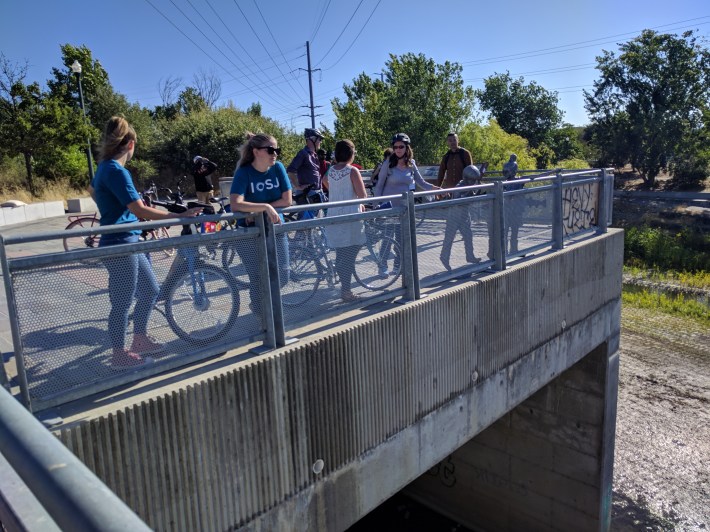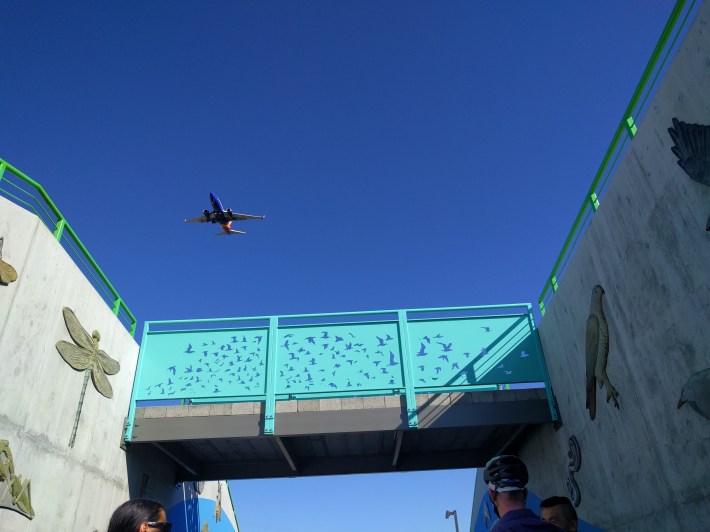Note: GJEL Accident Attorneys regularly sponsors coverage on Streetsblog San Francisco and Streetsblog California. Unless noted in the story, GJEL Accident Attorneys is not consulted for the content or editorial direction of the sponsored content.
The Guadalupe River River Park runs eleven miles, snaking through downtown San Jose, and includes pedestrian and bicycle paths. It is divided into two segments, the upper Guadalupe River and a longer segment along the Lower Guadalupe River.
On Friday, SPUR San Jose and the Guadalupe River Park Conservancy gave a tour of the lower portion. The leaders talked about the park's highlights, future development, and ongoing challenges to fifteen people who volunteer or are otherwise connected to efforts to improve this linear park and better connect it to the fabric of the city.
"SPUR wants attention paid to the investments going on around here," explained Michelle Huttenhoff, SPUR's San Jose Policy Director, who helped lead the tour. She pointed out that billions are going into redeveloping Diridon Station, Google is acquiring land and building a downtown office campus, and BART is coming, with lots of housing construction to follow. The River Park is poised to become an integral part of these new developments. But first, "we have to look for ways to remove barriers."

From the conservancy's web page:
Our vision encompasses gardens, trails and parks where natives and visitors alike can enjoy open spaces and natural habitats. We see a hub for social interaction, a retreat from urban life, and a place to come together for education, to honor our heritage, for colorful festivals and for physical fitness. We see our unique urban parkland as a flowing ribbon of opportunity – for our economic stimulation, and enhancing the quality of our lives. We see our park as the living centerpiece of a thriving San Jose.
Others on the tour had more modest, but no less important improvements in mind. "We're advocating for culturally based murals and volunteers to clean it," explained Emanuel Jacob, president of TRANSITion, a group of student advocates from San Jose State University. Jacob rode with Lydon George and Britt Bogue, also part of a student contingent of volunteers and advocates.

Meanwhile, many of the park's shortcomings are fairly obvious--and should get fixed as San Jose strives to make the streets that surround the park more friendly to bicycle riders and pedestrians.
For example, it is confusing to a newbie arriving by Amtrak to navigate past SAP Center, home of the Sharks hockey team. Cyclists and pedestrians have to cross wide intersections built for cars, with beg buttons and interminable wait times for everyone else. Part of the purpose of the tour was to get more familiar with those and other barriers, explained Jason Su, Executive Director of the Guadalupe River Park Conservancy. "The river park is part of a long chain... it's time for it all to become more of a Central Park for San Jose," he said.
All of this can make it hard to see the park's attractions in an integrated way. But if you are on a tour with people who know how to get around, its true beauty and potential becomes evident. After everyone assembled at the SAP center, Su and Huttenhoff guided the tour to its first stop at Confluence Point, seen below:

This area has a large plaza for the public to enjoy. This, as the proverbial crow flies, is only about 500 yards from Diridon Station. Huttenhoff said she hopes some kind of eye-catching artwork can be an anchor to help people find and enjoy this space. It needs "Something like the 'bean' in Chicago, to bring people together," she said.
There is already some artwork in the park, albeit not on the scale of the Chicago bean.

Another of those big barriers, however, is evident in the lead image and the picture below. Those cute houses are the shops of San Jose's Little Italy--something that should join naturally to the park. Instead, their backs face the park, and Little Italy is fenced off. The only road to it from the park side has a threatening "no trespassing" sign.

As Huttenhoff pointed out, Little Italy is just one example of this problem. There's a Trader Joe's and other shopping nearby, but separated by wide roads and facing away from it. Sections of the park are also divided by areas that are still overgrown and unkempt. There are also encampments along the way. "We don't want to gloss over the transient issues. It is a priority," said Su. That's going to require social work that goes beyond the capabilities of the Conservancy or SPUR.

"It'll take a diverse group of people. But it's inhumane to leave these people without the services they need," added Su.

Let's hope the advocates can achieve their goals, because there are some amazing spaces nestled along the river, including the Rotary Play Garden (seen below), that could become part of a network of community connections and destinations. Including, one would hope, services and shelter for the un-housed.

More pics of the park and the tour below.






Do you ride the Guadalupe trail or volunteer in the park? Let us know what you like about it, where it needs improvements, and how you see it tying into the city in the future.





